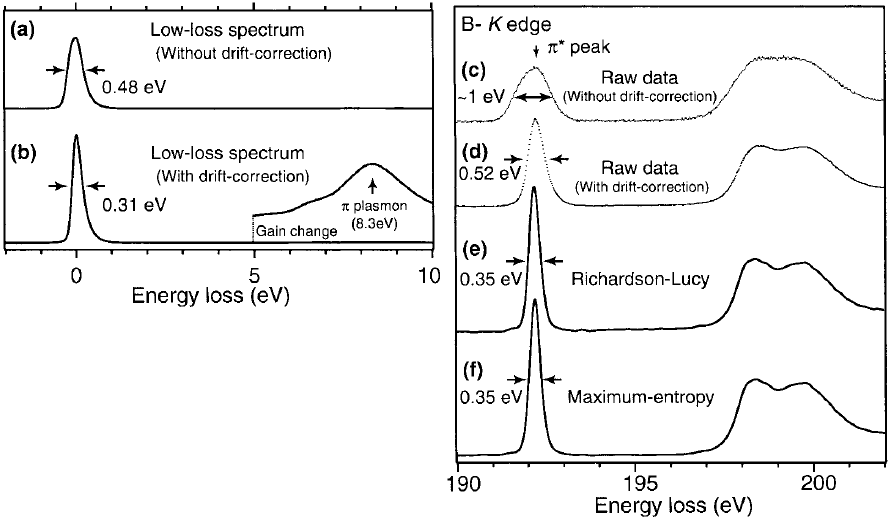=================================================================================
Zero-loss drift, spectrum drift and energy drift in EELS measurements may be induced by various instabilities, for instance:
i) Electronic noise in TEM and STEM systems.
ii) Thermal drift.
iii) Environmental interference.
It was proposed that the energy drift from low-frequency instabilities can be corrected by software techniques [1, 2], while the energy drift from high-frequency energy instabilities can be corrected by high speed acquisition technique [3].
A limitation of the magnetic prism-based EELS detection system is the spectrum drift in the energy dispersion direction. Various sources of instability in the microscope contribute to this effect: high voltage fluctuation, magnetic field creep etc. This places a fundamental limit on the useful exposure time. Furthermore, experimental efforts in electron spectroscopy consist largely in reducing unexpected electrical noise and specimen drift.
In order to improve the energy resolution of EEL spectrum, before spectrum deconvolution, scripts (e.g. applied in Gatan Digital Micrograph) can be used to automatically acquire and store each spectrum separately, and then to evaluate and correct the energy drift in each acquisition. [4, 5] After the drift correction, the EEL spectrum can be deconvoluted using software. For instance, some deconvolution techniques are Fourier ratio method, maximum-entropy (ME) [6,7] and Richardson–Lucy (RL) algorithms [8].
Examples in Figure 4891 shows the effects of energy resolution enhanced by energy-drift correction and deconvolutions in the EEL spectrum of h-BN. The EEL spectra are acquired with an exposure time of 80 ms, a probe current of 100 pA and a high energy-dispersion (0.021 eV ch–1). Figure 4891 (a) shows a blind-sum spectrum with a wide energy spread of 0.48 eV in FWHM (full width at half maximum) due to the energy drift during data acquisition. Figures 4891 (b) shows the improvement by the energy-drift correction, reflecting the inherent high energy-resolution of a cold field emission electron gun (CFEEG). Figures 4891 (c) and (d) show the boron K-edge spectra before and after drift correction, respectively, with π* peak reduced from 1 to 0.52 eV. Figures 4891 (e) and (f) shows further improvement by RL (Richardson-Lucy) and ME (maximum-entropy) deconvolution, respectively.

Figure 4891. Low-loss and core-loss spectra of h-BN. (a) and (c) raw spectrum, (b) and (d) spectra after drift correction, and (e) and (f) deconvoluted B K-edge ELNES using RL algorithm and ME algorithm, respectively.
Adapted from [5]
[1] Kimoto, K., Matsui, Y., 2002. Software techniques for EELS to realize
about 0.3 eV energy resolution using 300 kV FEG-TEM. J. Microsc.
208, 224–228.
[2] Kimoto, K., Ishizuka, K., Mizoguchi, T., Tanaka, I., Matsui, Y., 2003. The
study of Al-L23 ELNES with resolution-enhancement software and firstprinciples
calculation. J. Electron Microsc. 52, 299–303.
[3] Koji Kimoto, Kazuo Ishizuka, Toru Asaka, Takuro Nagai, Yoshio Matsui, 0.23 eV energy resolution obtained using a cold field-emission gun and a streak imaging technique, Micron 36 (2005) 465–469.
[4] Kimoto K and Matsui Y (2002) Software techniques for EELS to realize
about 0.3 eV energy resolution using 300 kV FEG-TEM. J. Microsc.
208: 224–228.
[5] Koji Kimoto, Kazuo Ishizuka, Teruyasu Mizoguchi, Isao Tanaka and Yoshio Matsui, The study of Al-L23 ELNES with resolution-enhancement software and first-principles calculation, Journal of Electron Microscopy 52(3): 299–303 (2003).
[6] Kuzuo R and Tanaka M (1993) Resolution enhancement of electron
energy-loss spectra using the maximum entropy method. J. Electron
Microsc. 42: 240–243.
[7] Overwijk M H F and Reefman D (2000) Maximum-entropy deconvolution
applied to electron energy-loss spectroscopy. Micron 31: 325–331.
[8] Gloter A, Douiri A, Tencé M, Imhoff D, and Colliex C (2002) Improving
energy resolution of EELS spectra: an alternative to the monochromator
solution. In: Proc. of 15th ICEM, Durban, South Africa, pp. 141–142.
|